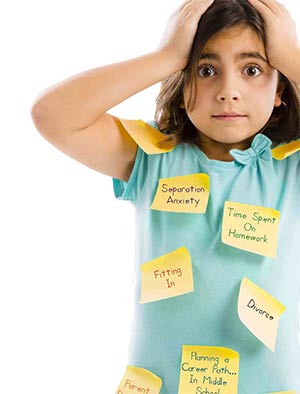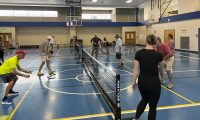
Stress is the result of the demands placed on us and our ability to deal with them. These demands can come from many places and can affect people of all ages. From preschoolers to high school graduates, the pressures often added by family, friends, school and extracurricular activities can eventually weigh down the most balanced of people.
However, it is important to remember that some levels of stress are normal. Amy L. Neloms, M.Ed., director of K-12 Guidance and Counseling with the Charleston County School District, pointed out “there is good stress and bad stress. When someone is excited about an activity, such as going to the prom or the first day of school, that is good stress. Bad stress is when someone is constantly stressed with severe anxiety.”
It’s useful to know about stress, whether your child is anticipating acquiring a driver’s license – normally good stress – or is experiencing bad stress that comes with social pressures.
Separation Anxiety
A parent typically feels more anxiety about leaving a young child than the child does, but, every so often, the fear of being left alone creeps into a youngster’s life – and it can become very unsettling. As early as a few months old, children develop what is called object permanence, which means they begin to learn that things and people exist even when they can’t see them.
Try to have all of your child’s other needs met, such as enough sleep and ample food. As frustrating as separation anxiety can be, know that when there is anxiety, it simply means that there is a loving bond between you and your child.
Time Spent on Homework
No one seems to agree how much time spent on homework for any age is good or bad. The debate is endless, and every family you speak with will have a different answer to this question.
A few years ago, the Organisation for Economic Co-operation and Development found that 15-year-olds in the United States spent an average of 6.1 hours a week on homework, while a survey by the University of Phoenix College of Education found that high school students in America spent up to 17.5 hours on homework per week, middle school students spent up to 3.2 hours per week and elementary children spent 2.9 hours per week.
Many students and their families find the amount of homework to be stressful. Some parents find that their children do better by doing homework in short yet regular bursts.
Fitting In
Just fitting in with the crowd is sometimes a difficult job for children. Social pressures abound, and, in every grade, there seem to be children who can’t quite find their niche.
“Fitting in and finding friends is tough for students in all grades,” Neloms explained. “It is something we encounter in all schools. Many of our counselors utilize small groups for students that are experiencing the same type of problem. It is a great resource for students to know that others are going through the same thing they are.”
For example, many Charleston County School District counselors have utilized the Girl Scout program “BFF” (Be a Friend First) to help young girls with the stress of fitting in. The BFF series, which is a part of the Girl Scouts’ highly acclaimed leadership program aMAZE!, has girls exploring issues and participating in discussion exercises.
Planning a Career Path … in Middle School
The idea of picking a course that may determine the rest of your life at 13 years old is daunting. It is easy to see why middle school students and their parents are frustrated by this new plan in schools, but many are looking at it in a positive light.
In 2005, The Education and Economic Development Act was passed to provide the infrastructure to support the implementation of Personal Pathways to Success, which includes an Individual Graduation Plan, or IGP. The idea is to help students move seamlessly from middle school to high school and post-secondary education and then to the workplace.
“In the Charleston County School District, the IGP is established in eighth grade,” explained Neloms. “A student picks a cluster – there are 16 different clusters of study – and it guides him or her on courses that will be helpful in that field of study. It is fluid but not set in stone. At any point, a child can alter their schedule, all the while keeping their parents and teachers on board.”

Divorce
Divorce happens, and many children that must adapt to two homes. Every family and every situation is a bit different, but the repercussions felt by children can range from mild to extreme.
Children of divorced parents often see themselves as the cause of the separation, so dialogue is important. The parents should sit with their kids, talk about the situation and answer all questions – even the difficult ones.
Parent Deployment
The life of a military family will always include deployment, but that doesn’t mean the time spent apart from a loved one is any easier. Children of deployed parents experience higher levels of stress than their civilian counterparts. Nearly 800,000 preschoolers are separated from a parent serving in the U.S. military.
The “Sesame Street” program “Talk, Listen, Connect” helps kids through deployments, combat-related injuries and the death of a loved one. For more information on the program, visit www.SesameWorkshop.org.
It’s also a good idea to communicate with the installations office of Child and Youth Services. To learn more, visit http://militaryinstallations.dod.mil.
Lastly, the National Center for Telehealth & Technology, a Department of Defense agency, created “Military Kids Connect,” which provides access to age-appropriate resources to support children dealing with the psychological challenges of military life. For more information, visit http://militarykidsconnect.dcoe.mil.
Social Media
Cyberbullying is a new term for many parents. Its definition encompasses many forms of technology, such as texting, mobile apps, console games, photos on a cellphone and social media sites.
Many children face the real problem of cyberbullying, especially in middle school and high school. In a random sampling of students 11 to 15 years old at a middle school in the Midwestern United States, 34.4 percent of students said they had been cyberbullied at some point. Most of them were girls.
Cyberbullying.org offers several tips for educators, parents and students alike on how best to deal with cyberbullying. Educators are often the first to notice the signs of bullying and cyberbullying among students. After School, Yik Yak, SnapChat, Ask.fm, Kik, Brighten and Whisper are all apps where users can post something for others to read anonymously.
Jostens, a leading printer of student-developed content, has launched a successful campaign called “Pause Before You Post.” It is a great resource for students who wish to learn how not to be a cyberbully and how to protect themselves from inadvertently putting private information on the Web. To learn more, visit www.jostens.com.
“It is important that parents are aware of their children’s social presence because teens aren’t always thinking about what they are posting,” said Neloms, who supports the Jostens campaign. “Colleges are really looking at a student’s online social presence.”






